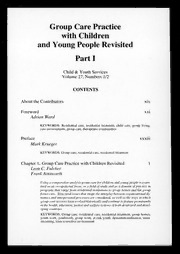
Child & Youth Services 2005: Vol 27 Table of Contents PDF
Preview Child & Youth Services 2005: Vol 27 Table of Contents
_Group Care Practice with Children and Young People Revisited Part I Child & Youth Services Volume 27, Numbers 1/2 CONTENTS About the Contributors Foreword Adrian Ward KEYWORDS. Residential care, residential treatment, child care, group living, care environments, group care, therapeutic communities Preface XXXill Mark Krueger KEYWORDS. Group care, residential care, residential treatment Chapter |. Group Care Practice with Children Revisited Leon C. Fulcher Frank Ainsworth Using a comparative analysis group care for children and young people is exam- ined as an occupational focus, as a field of study and as a domain ofp ractice in programs that range from residential institutions to group homes and kin group foster care. Structural issues that shape the interplay between organizational dy- namics and interpersonal processes are considered, as well as the ways in which group care services have evolved historically and continue to feature prominently in the health, education, justice and welfare systems of both developed and devel- oping countries. KEYWORDS. Group care, residential care, residential treatment, group homes, youth work, youthwork, group work, at-risk youth, deinstitutionalisation, main- streaming, least restrictive environment SECTION 1: WORKING DIRECTLY WITH CHILDREN, YOUNG PEOPLE, AND THEIR FAMILIES Chapter 2. The Soul, Rhythms and Blues of Responsive Child and Youth Care at Home or Away from Home 27 Leon C. Fulcher The knowledge base that underpins child and youth care work is re-examined through the device of musical metaphor, introducing six voices that impact on re- sponsive practices with children, young people, and their families. The Soul of child and youth care is located in guarantees of physical safety and security and at- tending to bodily comforts, routines, and preferences. Rhythms of proactive caring build through the unique developmental patterns presented by each child or young person cared for at home or away from home. The Blues of care are recorded in each social history and care order, highlighting stark emotions around significant life events, personal and cultural safety, risk-taking, and acting out, self-mutilation, or es- cape. Six comparative policy themes are highlighted, voicing challenges for child and youth services over the next decade. KEYWORDS. Group care, residential care, residential treatment, group homes, youth work, youthwork, at-risk youth, family-centered care Chapter 3. Developing Social Competencies in Group Care Practice Richard W. Small Leon C. Fulcher Any discussions about specialized helping environments for children or young people would be incomplete without reference to the relationships found between practices in group care centers and schools. This involves thinking ofa child's to- tal environment as a curriculum for teaching competencies and learning outcomes important to daily living. The task involves making a conscious effort to deal with a child’s functioning in the present, thereby avoiding diagnostic conclusions that emphasize difficulties in one area of their life as the cause of learning problems. KEYWORDS. Group care, residential care, residential treatment, group homes, youth work, youthwork, group work, at-risk youth, therapeutic milieu, cogni- tive-behavioural intervention, social competency Chapter 4. Group Care Practitioners as Family Workers 75 Frank Ainsworth This article sets out a rationale and provides a modfoer flami ly work by group care practitioners. In doing so it points out that practitioners will need to avoid parent blaming attitudes and become family-centered rather than simply child-fo- cused. Thus the critical issues to be addressed are how to ensure that a group care program is from an organization, policy, and practice perspective congruent with a family-centered model. [fit is not, then a program is unlikely to be able to work successfully with birth par- ents and family members. Birth parents and family members will instead feel alienated and, as a result, are unlikely to cooperate with the group care program and the practi- tioner workforce. In fact, the program will have failed to incorporate family members into the care and treatment plan and to work with them as partners in this process even when it is in the best interest ofa child or youth. KEY WORDS. Group care, residential care, residential treatment, group homes, youth work, youthwork, group work, at-risk youth, family work, therapeutic milieu SECTION 2: WORKING INDIRECTLY TO SUPPORT CHILDREN, YOUNG PEOPLE, AND FAMILIES Chapter 5. Primary Care in Secondary Settings: Inherent Strains —87 Henry W. Maier Introduction by Thom Garfat There is an ever present struggle associated with reconciling primary care require- menfort chisldr en and young people living in group care programs with secondary or- ganizational demands imposed by external agency expectations and administrative requirements. That struggle finds its expression and potential balance in the daily work ofs taff. This classic manuscript in the literature of child and youth care offers an enduring analysis of the interplay between primary and secondary care issues that shape responsive group care services. KEYWORDS. Group care, residential care, residential treatment, group homes, youth work, youthwork, group work, at-risk youth, care workers, ecology of care, direct care Chapter 6. Developing a Shared Language and Practice 117 Stephen F. Casson The provision of a coherent “parenting,” “teaching,” and “developmental” pro- gram is a complex undertaking. It has all the makings of an organizational, mana- gerial, and therapeutic nightmare when different types of workers, with marked differences in personality and values, become responsible for different children with a variety of problems in a living-learning environment. Without an action plan to help engender a shared languagfeo r practice, the needs of both children and staff are at risk. KEYWORDS. Group care, residential care, residential treatment, group homes, youth work, youthwork, group work, at-risk youth, direct care Group Care Practice with Children and Young People Revisited, Part II will follow in Child & Youth Services, Volume 28, Numbers 1/2.
